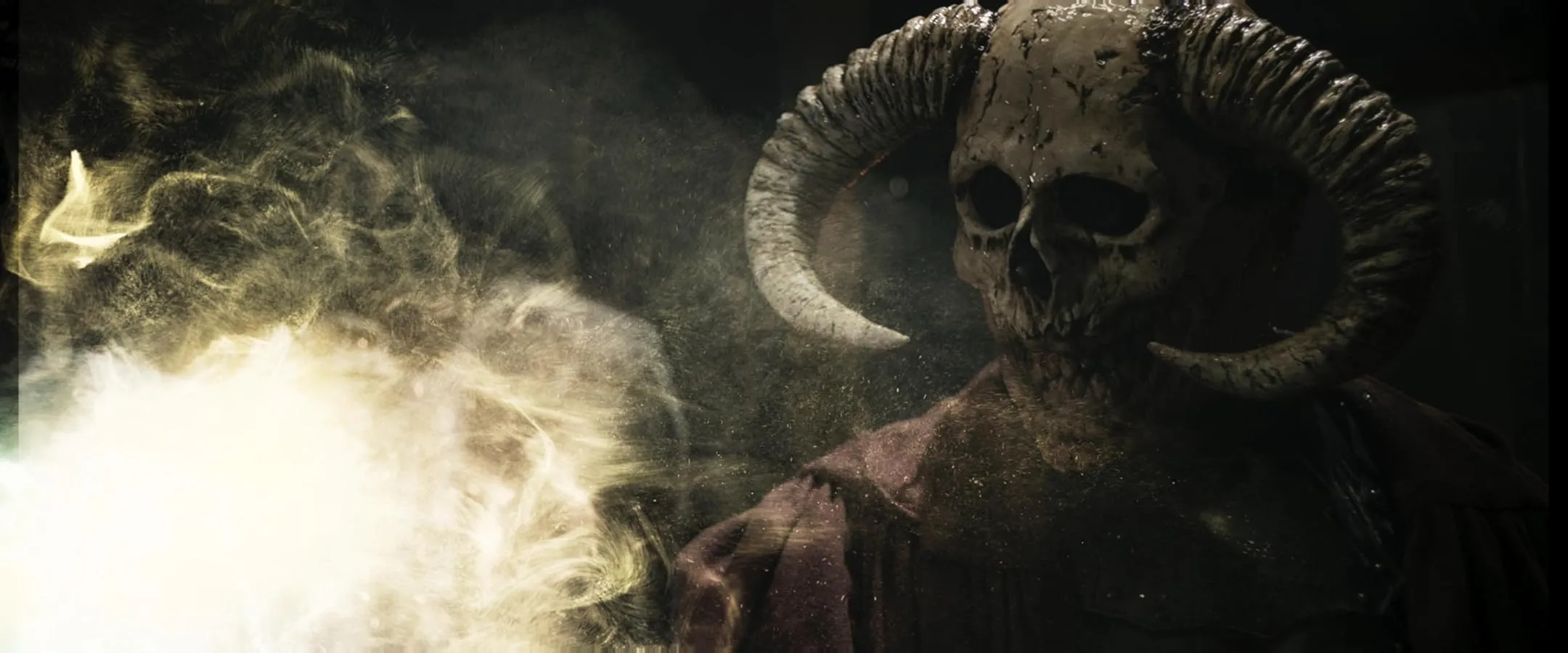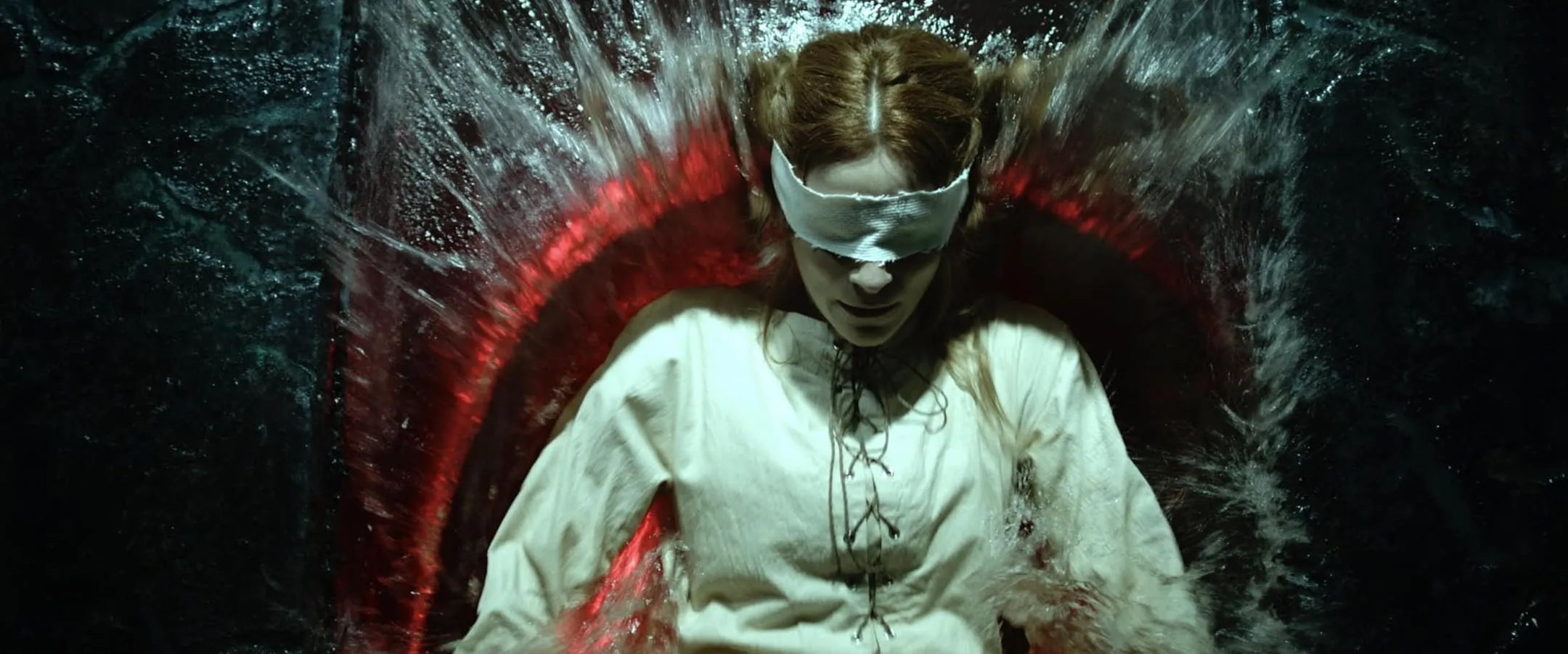The film sets us into a shadowed medieval world where darkness and mysterious magic command center stage. It follows the quest of a knight who finds himself challenged by an ominous curse, armed only with a talisman that grants a peculiar form of repeated mortality.
The plot is triggered by the rescue of a red-haired young woman whose fate is intertwined with an ancient prophetic decree. This quest, laced with a series of cursed trials and encounters with eerie adversaries, immediately establishes stakes that feel both personal and mythically significant.
The visual tone of the production leans into a gritty and murky ambiance—a look that, while constrained by budget, radiates a tactile sense of authenticity. The film crafts its mood through the interplay of shadow and sparse light, building an atmosphere that is equally foreboding and tangible.
At the core of this narrative lie two protagonists whose paths diverge in purpose: Bhodie, the determined knight burdened by the weight of destiny, and Avalon, a mysterious figure whose motivations are shrouded in personal history and quiet defiance. Their conflicting desires drive a core struggle against a canvas of ancient curses and spectral forces, setting up a narrative tension that challenges both tradition and expectation.
Unraveling the Quest
The film ignites its narrative with a clear spark—a prophecy that compels Bhodie into action as he sets off to save Avalon, the red-haired figure whose destiny has shaped the stakes of their world. From the moment this fateful call rings out, we witness the plunge from a familiar realm into one steeped in ancient curses and eerie dimensions. This shift is marked by an intensification of both the physical and emotional terrain, drawing the viewer into an otherworldly struggle where fate exerts a heavy hand.
At the heart of the tale lies a rescue effort that carries implications far beyond a simple act of heroism. Bhodie’s mission to retrieve Avalon from a dark ritual and a cursed environment injects the narrative with a pressing tension that hints at the weight of collective destiny.
The film takes care to outline the challenges ahead, with the retrieval of three enchanted stones standing as milestones in the quest. The magical talisman, a device that repeatedly restores life, functions as a constant reminder of the narrative’s inventive use of recurring fatality and rebirth—an approach that spices up the unfolding conflict.
The pacing of the story is a study in contrast. High-stakes combat sequences erupt with sudden ferocity, while quieter moments dedicated to the lore allow the audience to absorb the cultural mystique of the setting. These interludes, though measured, ensure that the dramatic beats never lose their impact. Occasional shifts in alliances and unexpected betrayals render the quest less predictable, inviting a closer examination of character decisions and the overarching mythos.
Not everything is tied up neatly, as gaps in the backstory leave a mysterious quality that lingers. These open-ended threads gently tease more complexities in the world without hampering the central narrative, offering room for the imagination to fill in the hidden details.
Characters in Conflict: Voices and Vigor
Bhodie stands as the story’s central figure, a knight weighed down by duty and the harsh cost of his repeated demises. His role in the quest to rescue Avalon is marked by inner battles that surface during moments of fierce combat as well as in quieter interludes.
The performance captures the strain of a man forced to confront the inevitability of fate while clinging to the hope of saving a life. His physical struggles are mirrored by subtle gestures that reveal a troubled interior, adding layers to his otherwise straightforward heroic quest.
Avalon, introduced as a figure marked by mystery, carries the scars of a troubled past that have left their mark on her resolve. The portrayal offers glimpses into a character who is both hardened by personal loss and yet reflective in her defiant silences.
Her interactions show a careful balance between the need for vengeance and the weight of destiny, providing a counterpoint to Bhodie’s overt expressions of determination. Her performance suggests a resilience that allows room for complexity without overexposure.
Supporting roles contribute significantly to the narrative fabric. William, Bhodie’s older half-brother, provides an anchor of reliability amid the chaos, his presence underscoring themes of sacrifice and unwavering commitment. The character of the Keeper operates in a space of moral ambiguity, presenting himself as a guide whose own agenda leaves the audience questioning his every move. These secondary figures enrich the conflict through their layered portrayals, challenging the protagonists at every turn.
Interactions between Bhodie and Avalon evolve from cautious reserve to a partnership edged with mutual reliance. The dialogue, oscillating between archaic proclamations and terse battle cries, sharpens the characters’ distinct voices. The cast’s physical expressiveness and measured delivery contribute decisively to the narrative’s tension, compensating for the limitations inherent in a modest production.
Symbols and Kingdoms: The Fabric of the World
The narrative places heavy emphasis on the tension between destiny and personal choice. Bhodie’s repeated returns from death serve as a constant reminder of the struggle between an unchangeable fate and the weight of individual decisions. The film uses the resurrection cycle to cast light on the high cost attached to each sacrifice, inviting the audience to question if actions are predetermined or subject to change through personal resolve.
Sacrifice and redemption receive thoughtful attention through the presence of the talisman. Its promise of repeated life raises questions about the price of survival when every revival requires forfeiting something of the soul. Characters are forced to confront what is lost in pursuit of a future reclaimed by hope, as symbolic artifacts like the talisman and the trio of enchanted stones stand as markers of both blessing and curse.
Visual storytelling reinforces these ideas. Recurrent images—a dense, dark wood; ruins of long-forgotten fortresses; weathered armor—create an atmosphere rich in myth and sorrow. The contrast between flickering shadows and sparse light captures internal conflicts, emphasizing the struggle between moral dualities that challenge each character’s beliefs and actions.
Ancient prophecies and mythic lore underpin the setting, suggesting a world shaped by legends and age-old omens. The film constructs its realm through both careful production design and deliberate dialogue, creating a vivid stage where supernatural forces interact with human frailty. Each visual detail and spoken word contributes to a sense that the world itself is aware of its tragic history, adding a quiet intensity to the narrative framework.
A Visual Renaissance on a Lean Budget
The director imposes a visual narrative that merges dark fantasy with elements of horror, proving that a limited budget does not shackle creative drive. The stylistic choices contribute to a tangible atmosphere where every shadow carries narrative weight. Several close-up shots capture raw emotion during quieter moments, contrasting with sweeping frames that reveal the scale of dramatic action.
Camera work is executed with precision; intimate moments are framed tightly to highlight internal conflict, while wider compositions allow the audience to witness expansive battle scenes and desolate landscapes. Lighting is employed with care, using stark contrasts to accentuate both the mystical allure and the stark menace of the settings. Shadows and flickering light sources work together to sculpt a world that feels both ancient and persistently alive.
Set design plays a significant role. The armor, costumes, and elaborate makeup provide authenticity, ensuring each detail contributes to the audience’s understanding of the characters’ journeys and the harsh environment they inhabit.
Inventive set pieces—ranging from eerie dungeons to overgrown ruins—lift the narrative from mere dialogue, transforming each scene into a visual echo of forgotten legends. Practical effects are applied in combat sequences and creature portrayals, lending a tangible quality to the clashes and the supernatural encounters on screen.
Digital enhancements support the practical elements seamlessly. Special effects establish believable supernatural events that punctuate the action without overwhelming the production’s raw, tactile energy. Several key moments exhibit creative ingenuity, where constrained resources yield imaginative solutions that bolster the storytelling experience.
This approach brings forth a visually compelling narrative while deftly sidestepping excessive reliance on expensive effects, leaving the viewer immersed in a vividly crafted realm that resonates with both authenticity and ambition.
Soundscapes and Cinematic Pulse
Sean Croley’s score pulses with a measured cadence that marks the film’s shifts between tension and quiet reflection. Its solemn undertones and sharp crescendos mirror both the grand conflicts and the softer moments of human frailty. The recurring musical themes enhance the sense of epic stakes while also carving out intimate spaces for the characters’ struggles.
Sound effects emerge with clarity—clashing swords, hushed whispers, and low, echoing roars—all synchronizing with the visuals in a way that intensifies each dramatic turn. Audio cues often coincide with striking moments on screen, drawing the viewer deeper into a realm that is simultaneously bleak and richly mysterious.
The careful interplay between dialogue, layered music, and ambient noise shapes a cinematic atmosphere that makes the film’s narrative environment feel palpably real, engaging the senses throughout the unfolding chapters without ever overwhelming the core storytelling.
The Spell of Enduring Myth
The resurrection talisman stands out as a clever narrative device, injecting a repetitive cycle of demise and revival that challenges conventions of heroic progression. Its repeated use not only complicates the physical trials faced by the knight but also enriches the internal struggle with fate, adding a layer of gravity to each resurgence. The repeated confrontations with mortality shift the standard fantasy setup into a stage of continual recalibration, where each rebirth prompts new questions about sacrifice and persistence.
The film skilfully blends elements of horror with the classic sword-and-sorcery formula, resulting in a tone that appeals to both fantasy enthusiasts and fans of darker narratives. This approach ensures that while the film operates within familiar genre tropes, it refreshes the experience by infusing the narrative with unsettling moments that keep audiences on edge.
It speaks directly to those who favor stories that balance intense action with introspective character struggles. The visual set pieces and defined character relationships make for scenes that remain memorable despite the constraints of a modest budget. The film appears capable of inspiring future projects that aim to balance practical limitations with inventive storytelling, offering a model for crafting compelling genre pieces that resonate with dedicated viewers.
The Review
A Knight's War
A resourceful approach to narrative structure and visual storytelling ensures this film leaves its mark despite financial constraints. Cleverly implemented cycles of renewal add complexity to its heroic journey, while strong visual moments and solid performances keep the viewer invested. Even as some sequences suffer from uneven pacing, the film remains an engaging exploration of fantasy storytelling. It may confuse at times, but its ambition and creativity make it a worthwhile watch.
PROS
- Strong narrative structure
- Engaging performances
- Clever use of the resurrection theme
- Effective atmosphere and visual tone
- Solid mix of horror and fantasy elements
CONS
- Pacing can feel uneven
- Some narrative repetition
- Budget constraints are evident in places





















































